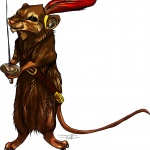Pets, be they cats, dogs, birds or toads do enmesh themselves in our lives, with most people owning a pet at some stage of their lives. So it is not to be wondered that they infiltrate works of fiction as surely as they twine themselves into our lives.
Dogs and cats have been companion animals for thousands of years, gradually adapting even their body shape to the needs of humans. Dogs have been bred to perform many different tasks, from terrier rat catchers to greyhound racers or huskies pulling sleds, there is a dog type for most human needs. The ever loving and adaptable dog even becomes a human bodyguard, sniffing out cancers with their perceptive noses, or contraband at border security – and all this work for nothing more than treats and some affection. Dogs have been beside the human race, panting with eagerness since we first sighted game from the mouth of the cave.
Dogs in fiction also bolster this image, with many retellings of heroic dogs and their deeds saving humans. Jean Auel has Wolf, the precursor to domestic dogs, giving an insight into the possible path of dog domestication. A dog had the distinction of being the first host in ‘Alien’ although this is unlikely to be a favourite scene for animal lovers.
Cats stepped up to the mark with the dawn of agriculture. They were already hunters of rodents, so made little adaptation to be able to fit into human society. Cats roamed the trade routes, eating rats across the oceans, and travelled across the globe, snoozing comfortably in the back of a wagon. Today they still perform vital rat catching services in museums such as the Hermitage Art Museum in Russia, and can still often be found in bookshops. The book ‘Dewey the library cat,’ tells the charming story of an abandoned kitten who lives in the library and helps spread the love of books and cats.
Cats in fiction reflect some of their history, and yet they are more developed than other pets in fiction. I postulate this is because many writers struggle to write with a cat draped over one arm, or sitting in front of the screen, so they force their way into the story! A writer is nothing more than a warm lap for cats. Science fiction writers such as Andre Norton and Robert Heinlein often had cats in the story, and sometimes as the main character. Readers may remember or like to read the ‘Zero Stone’ series of Norton, or ‘The Cat who walks through Walls’ by Heinlein. Andre Norton has a cat on her lap in her wiki author photo as well. Another of her books is ‘Breed to Come’ a post apocalypse book with evolved cats (leading society naturally!), dogs and the evil rats. An excellent read. Other large, sentient cats in novels are the ‘Gandalara Cycle’ by Randall Garrett, where the characters and cats form a strong telepathic/empathic bond. Alan Dean Foster also has the furcot- giant 6 legged cat beasts – in Midworld, which is an excellent read. JK Rowling had Crookshanks, Hermione’s familiar who was instrumental in saving the main characters. Lewis Carroll had the Cheshire cat, while CS Lewis seemed altogether less keen on cats, making the cat a deceiving villain in ‘The Last Battle’.
Birds – particularly parrots with their high intelligence and ability to mimic – also make popular pets. Notorious pirates can be readily identified by their companion parrot, such as RL Stevenson’s Long John Silver as well as the real pirate Blackbeard. The marooned Robinson Crusoe had a bad moment when he was awakened by his parrot talking. The paranoid Crusoe panicked, hearing a ‘human’ voice, as well he might after 26 years mostly alone with the only other humans sighted being cannibals.
Other pets perhaps fair less well in fiction. Rats suffer from their association with garbage and their ability to survive. ‘Willard’ is not for the faint hearted, being a tale of a social outcast and his too intelligent rats. Even JK Rowling cast the rat as a bad guy, with Scabbers being the notorious dark wizard and Voldemort henchman, Peter Pettigrew. Although we have the flipside with the charming series ‘Rats of NIHM’ by Robert O’Brien, where the rats are mostly intelligent heroes, although the books have a range of good and bad rats, as well as the mice, who are in general more heroic. Reepicheep the mouse in the ‘Dawn Treader’ by CS Lewis is the epitome of heroism.
So as they have travelled beside humans throughout evolution, it seems likely our pets will continue as companions to the stars and beyond. Certainly they have travelled there often in the imaginations of writers. As we encounter and evolve on the strange worlds beyond Earth, maybe the stories will come true and we will be able to share the journey as equals.
Enjoy this blog? Have a think about signing up via my website or catch them as they fly around the ether on twitter or facebook. They will stay where they are pinned on pinterest.
For those that have not read Druid’s Portal yet, here is a link to the first chapter DruidsPortal


I have noticed that we can kill people in novels left and right and scarcely get a reaction from people but when you kill a dog people have a very visceral reaction. Thanks for the post!
I think because animals trust us, it strikes harder with people.